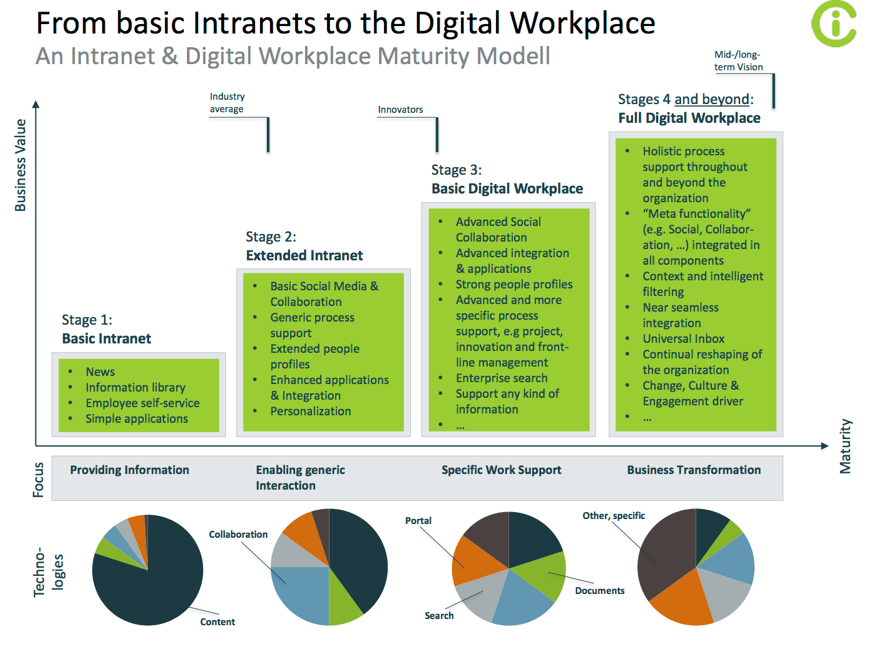Digital workplaces are all the rage these days, and for good reason. By creating a personalized and interactive online environment, businesses can boost employee engagement, improve knowledge sharing, and ultimately drive innovation. These benefits are driving the trend of digital workplace transformation across industries. But what exactly is a digital workplace, and how can you transform your existing intranet into one?
Digital Workplace Transformation: Overcoming Outdated Intranets
Many businesses struggle with outdated intranet systems that hinder communication and collaboration. These intranets often act as information repositories rather than dynamic hubs for collaboration and communication. Employees may feel frustrated when they waste time searching for information. They may also struggle to share knowledge across departments. Additionally, they may experience a sense of disconnection within the organization.
Personalization: The Heart of a Thriving Digital Workplace
At the heart of a successful digital workplace transformation lies personalization. Imagine an intranet that tailors itself to each employee’s needs. This could involve allowing users to personalize their dashboards with widgets for the tools they use most frequently, such as customer relationship management (CRM) software for the sales team or social media scheduling tools for the marketing team. Personalization not only streamlines workflows but also empowers employees to find what they need quickly and efficiently.
Personalization allows workers to quickly locate relevant files and projects. It also encourages file sharing and facilitates collaboration in ways that traditional intranets do not. Personalization can help organizations simplify their online security as well. When intranets are customized, it’s easy for companies to assign individualized permissions to varying employees. This can vastly improve online security.

LiveTiles Intranet: A Personalized Solution
LiveTiles provides a modern and user-friendly Intranet platform that organizations can personalize to meet their specific needs. With LiveTiles, employees can personalize their dashboards by adding widgets and shortcuts to the tools and information they use often. This fosters a more engaged workforce by giving employees a sense of ownership over their digital workspace.
Future-Proofing with Technology
The future of digital workplaces is bright, and several key trends are shaping the way we work online. Cloud storage solutions offer a secure and scalable way to store and access company data. This eliminates the need for bulky on-site servers and makes information readily available from anywhere with an internet connection. Cloud storage can also streamline data backup and disaster recovery, while also reducing IT costs.
AI has the potential to revolutionize worker productivity. Imagine an AI assistant that anticipates your needs based on past activity. For instance, if you’re working on a client proposal, the AI might automatically surface relevant market research data or competitor analysis reports. As workers continue to generate data through their daily activities, AI can identify complex patterns and predict their future needs, saving them valuable time and effort. With the ever-increasing use of mobile devices, prioritizing a mobile-friendly intranet is no longer optional.
A well-designed mobile app ensures employees can access company resources, collaborate with colleagues, and stay informed on the go. This fosters a more connected and productive workforce, regardless of location.
LiveTiles Intranet integrates seamlessly with cloud storage solutions and offers AI-powered features to personalize the user experience. This ensures your digital workplace is not only user-friendly today but also adaptable to future technological advancements.
The Advantages of Workplace Transformation
Digital workplace transformation unlocks a treasure trove of benefits for businesses. Improved knowledge sharing and collaboration are key advantages. Easy access to information and user-friendly collaboration tools break down departmental silos, fostering a more connected and knowledgeable workforce. This enhanced collaboration creates a breeding ground for innovation, where employees can share ideas and build upon each other’s expertise.
Data-driven decision making is another advantage. Centralized information and real-time insights empower businesses to make informed choices that drive strategic success.
Furthermore, a modern digital workplace equips your organization with the agility to adapt quickly and compete more effectively in today’s dynamic market. Perhaps the most significant benefit lies in employee engagement and satisfaction. A well-designed digital workplace fosters a sense of community and empowers employees, leading to a more engaged and satisfied workforce, ultimately propelling your business forward.
Why Digital Transformation is Important
In today’s dynamic business landscape, digital transformation is no longer a luxury, it’s a necessity. Several factors underscore this importance. Firstly, customer expectations are constantly evolving. Consumers today crave seamless and digital experiences, and a modern digital workplace empowers businesses to deliver just that. Secondly, the rise of remote work demands a robust infrastructure. A well-designed digital workplace provides the essential tools and resources to effectively support a geographically dispersed workforce.
Finally, the need for increased efficiency is paramount. Digital transformation offers the key to streamlining workflows, automating repetitive tasks, and ultimately boosting overall business productivity. By embracing digital transformation and creating a modern digital workplace, businesses can stay ahead of the curve, deliver exceptional customer experiences, and thrive in today’s competitive environment.
The Challenges of Digital Workplace Transformation
Digital workplace transformation offers a wealth of advantages, but it’s not without its hurdles. One key challenge is change management. Transitioning employees from a familiar, traditional work style to a digital environment can lead to resistance. Implementing effective change management strategies is crucial to overcome this hurdle and ensure employee buy-in.
Security is another important concern. In a digital workplace, robust security measures are paramount to protect sensitive data. Businesses need to invest in solutions that safeguard information while still facilitating collaboration and accessibility.
Finally, integrating new technologies with existing systems can be complex. Careful planning and implementation are essential to ensure a smooth transition and avoid compatibility issues. By acknowledging these challenges and developing strategies to address them, businesses can navigate the digital workforce transformation process more effectively.
How to Create a Productive Digital Workforce
Creating a productive digital workplace requires a strategic approach. Here are the key steps involved:
1. Establish Goals:
Define your desired outcomes for the transformation. Do you want to improve communication, boost employee engagement, or streamline workflows?
Setting clear goals helps you choose the right technologies and measure the success of your initiative.
2. Select Appropriate Technologies:
Consider your goals and needs when choosing digital workplace tools. Don’t get overwhelmed by the latest trends; focus on solutions that address your specific challenges.
Cloud storage, collaboration platforms, communication tools, and project management software are some core elements to consider.
3. Develop an Action Plan:
Create a roadmap outlining the steps involved in the transformation process.
This plan should include timelines, resource allocation, responsibilities, and communication strategies.
4. Implement and Train:
Roll out the new digital workplace tools gradually.
Provide comprehensive training to ensure employees understand how to use the new features and functionalities effectively.
5. Ongoing Training and Support:
Offer ongoing training and support to address employee questions and concerns as they arise.
Regularly assess training effectiveness and adjust as needed.
6. Monitor Progress:
Track key metrics to measure the success of your digital workplace transformation.
This could include employee engagement surveys, productivity data, or collaboration tool usage statistics.
7. Encourage Collaboration:
Foster a culture of collaboration by promoting the use of communication and collaboration tools within the digital workplace.
Recognize and reward collaborative efforts.
8. Utilize Automation:
Identify repetitive tasks that can be automated using workflow tools or AI-powered solutions.
This frees up employee time for more strategic work.
9. Analyze Results:
Regularly analyze the data you collect to assess the impact of your digital workplace transformation.
Identify areas for improvement and adapt your strategy accordingly.
10. Promote Professional Development:
Leverage the digital workplace to offer employees access to online learning resources and professional development opportunities.
11. Leverage Remote Working Opportunities:
A well-designed digital workplace empowers a remote workforce.
Utilize features that facilitate communication, collaboration, and task management for geographically dispersed teams.
12. Measure Performance & Adjust Strategies Accordingly:
Continuously monitor performance metrics to assess the effectiveness of your digital workplace. Be prepared to adapt your strategies based on the data you collect to ensure optimal results.
Keys to Sustaining Long-term Success with Digital Workplace Transformation
The key for long-term success with digital workplace transformation lies in a three-pronged approach. First and foremost, securing leadership buy-in is paramount. Executive sponsorship provides the resources, direction, and commitment needed to drive the initiative forward. Secondly, actively involving employees in the planning and implementation process fosters a sense of ownership and increases the likelihood of adoption. When employees feel heard and invested in the process, they become champions for the new digital workplace.
Finally, cultivating a culture of continuous improvement is essential. The digital landscape is constantly evolving, so embracing ongoing adaptation ensures your digital workplace remains modern, effective, and responsive to the changing needs of your organization and workforce. By prioritizing these three key elements, businesses can unlock the full potential of their digital workplace transformation and achieve lasting success.
Why Digital Workplaces Require Transformation
Traditional intranets often fall short of meeting the needs of today’s digitally savvy workforce. They can be static and unengaging with outdated intranets offering a poor user experience and fail to capture employee attention. Employees become siloed and inaccessible with Information scattered across multiple platforms, making it difficult for employees to find what they need. They can often lack collaboration features with traditional intranets being limited in their ability to facilitate real-time communication and collaboration.
By transforming your digital workplace, you can overcome these limitations and create a dynamic and engaging environment that empowers your employees and fuels business success.
Author: Imran Uddin

About Imran Uddin:
Imran Uddin is a SEO/SMO and a Digital Marketing expert. He has been working on blogs and websites for approximately 5 years. He started his journey at the age of 18, and now builds and grows businesses online. His company runs multiple web portals, working on products that make people’s lives more comfortable.
Building a High-Performance Digital Workforce: Your Strategic Guide | Craft a roadmap to success! This guide explores key steps involved in creating a productive digital workplace, from establishing goals to fostering a culture of collaboration.





